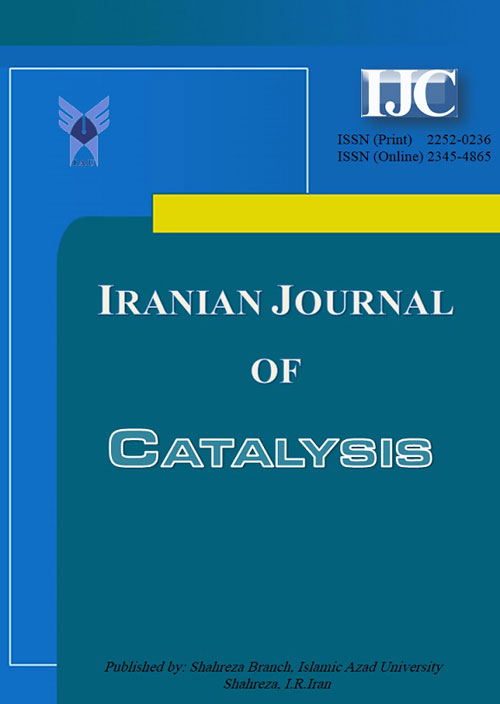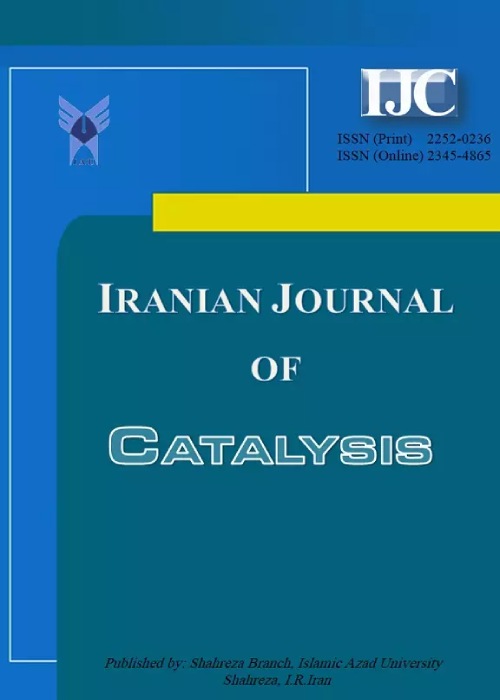فهرست مطالب

Iranian Journal of Catalysis
Volume:11 Issue: 1, Winter 2021
- تاریخ انتشار: 1400/01/22
- تعداد عناوین: 10
-
-
Pages 1-11
Enriched characteristics like porosity, stability and specific surface area assist TiO2 to find extensive applications in photocatalysis, dye sensitized solar cell, and sensors. TiO2 semiconductor was prepared using titanyl acetylacetonate and characterized by XRD, FTIR, Raman, UV-Vis, FESEM, EDX, and DLS. XRD result confirmed the tetragonal structured anatase TiO2 semiconductor. Scherrer formula is used to calculate crystallite size and the obtained value is 6.81 nm. Microstrain, stress, energy density, and crystallite size are calculated using W-H model. The absorption peak of TiO2 is observed at 652.11 cm-1 from FTIR spectrum and authenticated the anatase TiO2 semiconductor. The UV absorption edge is identified at 365 nm and the bandgap is calculated from the Kubelka-Munk equation using Tauc plot. Raman spectrum show bands at 140,197, 395, 512, and 635 cm-1 and these peaks confirmed the presence of the anatase TiO2 stretching mode. FESEM micrographs exhibited agglomerated spherical morphology and the particle size was further analysed using DLS study. The elemental compositions were identified in the EDX analysis. The obtained spectrum showed 55.88 Wt% of O and 44.12 Wt% of Ti atoms. The prepared anatase TiO2 semiconductor indicated enhanced catalytic behaviour. The rate constants and half life time are related to crystallite size using mathematical relation. It is found that the degradation process varies with crystallite size.
Keywords: TiO2, Sol-Gel, XRD, strain, UV-Vis, Photocatalysis -
Pages 13-21
Aluminophosphate and metal incorporated aluminophosphates have been synthesized at ice-cold temperature by simple co-precipitation method in the absence of a templating agent. Surface and bulk properties of synthesized materials were studied by different characterization techniques. The materials were found to be X-ray amorphous. N2 adsorption-desorption studies exhibited the existence of microporous structure and uniform narrow slit type of pores on the materials. The catalytic activity of the synthesized material was tested in phosgene free synthesis of carbamates from corresponding amines and dimethyl carbonate (DMC) through a greener route. Metal incorporated Aluminophosphates indicated excellent catalytic activity compared to pure aluminophosphates. Zinc aluminophosphate catalyst exhibited 83% carbamate yield with 100% selectivity towards the formation of carbamate. The excellent catalytic activity of Zinc aluminophosphate with 94% amine conversion is attributed to its surface properties mainly moderate acid strength. The incorporated metal plays a vital role in the structural and textural properties of aluminophosphates. A systematic study was conducted to correlate the catalytic activity and surface properties of metal aluminophosphates. Reaction conditions were optimized to obtain a better yield through phosgene free eco-friendly routes using different amines. The catalyst was found to be recyclable for 5 cycles in the desired reaction without a reduction in conversion and selectivity.
Keywords: Zinc aluminophosphates, Solid acid catalysts, Phosgene-free synthesis, Dimethyl carbonate, Organic carbamates -
Pages 23-35
Catalytic oxidation of D-glucose to D-gluconic acid derivative with H2O2 has been studied using non-noble Cobalt supported catalyst. The catalysts were synthesized using the scalable incipient wetness impregnation method of Co/Al2O3 and Co/TS1. The catalysts have been characterized by TGA, XRD, FESEM-EDX, BET, FTIR, and Hammett test. The oxidation of the D-glucose into D-gluconic acid with yield of 82% (as sodium gluconate) and selectivity is about 100 % have been achieved in the presence of 5 wt.% Co/Al2O3 as a catalyst under mild reaction conditions (60 oC, pH 9, 1atm, 3h). Reusability study of Co/Al2O3 was proven to be stable for subsequent cycles of reaction with no notable changes in selectivity. Besides, the physic-chemical properties of spent catalyst were similarly characterized through FTIR and Hammett test analysis. The presence of gluconic acid was confirmed by HPLC. The apparent activation energy of reaction is 15 kJ mol-1 which is lower than the value reported by prior-art using gold catalysts suggesting different mechanism with dissimilar rate-determining step. The activation of H2O2 is mediated by Co crystallites on the catalyst surfaces, forming active oxygen species via hydroxyl and peroxyl radical intermediates and/or oxometal species. The basic sites on catalyst facilitate the activation of glucose. The findings could help to make a cost-effective catalyst for D-glucose conversion into valuable organic acid chemical.
Keywords: Cobalt supported catalyst, Non-Noble Metal, D-Glucose oxidation, D-Gluconic acid, Sodium Gluconate -
Pages 37-48
A green and efficient trifluoroacetate-bonded polyethylene graphene oxide composite was utilized in this research to prepare benzimidazoles with good to excellent yield under a solvent-free condition. The trifluoroacetate-bonded polyethylene graphene oxide composite was constructed by polyethylene/diethylenetriamine-functionalized graphene oxide composite bonded by 2-aminothiazole and CF3COOHmoieties. Fourier transform infrared (FTIR) spectroscopy, X-ray diffraction (XRD) analysis, field emission scanning electron microscopy (FESEM), energy dispersive x-ray spectroscopy (EDS), and thermogravimetric analysis (TGA) were also employed to characterize the composite. Benzimidazoles were synthesized by reacting 1,2-phenylenediamine with aromatic aldehydes in the presence of composite (0.02 g) under solvent-free conditions at 75°C. The composite was recovered and used in five runs without considerable loss of activity. Compared to the other catalysts employed for the synthesis of benzimidazole, the present composite (catalyst) benefits from a series of advantages such as cost-effectiveness, easy storage and handling, recoverability and durability, environmental friendliness, non-metallic nature, and ease of disposal. The present synthetic route has also some advantages, including, moderate condition, easy workup, solvent-free nature, and environmental safety.
Keywords: Polyethylene composite, Graphene oxide, trifluoroacetic acid catalyst, Benzimidazole, Solvent-free -
Pages 49-58
In this work, ZrO2/TiO2/ZnO ternary nanocomposites were prepared by the sol-gel technique. The Taguchi method with the L9 orthogonal array was utilized to optimize the experimental conditions for the preparation of nanocomposites. The design has four factors, and each factor has three levels. The design factors of this study were calcination temperature, the aging time, the calcination time, and ultrasonic irradiation duration. Furthermore, as-synthesized structural features of nanocomposites were characterized, utilizing XRD, BET, FESEM, and EDX. The photocatalytic activities of all ZrO2/TiO2/ZnO nanocomposites were evaluated by the photodegradation of Congo red (CR) as an azo dye. The photocatalytic property of nanocomposites was enhanced by decreasing particle size and increasing the surface area. The best sample photodegraded 97% the CR solution within 15 min under an 8W UV lamp. The optimal conditions were achieved as 400 ºC calcination temperature, 72 h aging time, 4 h calcination time, and 30 min duration of ultrasonic irradiation for CR solution photodegradation. The effect of each parameter was evaluated using ANOVA analysis. The kinetics results showed the pseudo-first-order reaction mechanism for the photocatalytic activities of the nanocomposites.
Keywords: Taguchi Method, Synthesis condition, Optimization, Photodegradation, ZrO2, TiO2, ZnO nanocomposite -
Pages 59-67
In this research, design and synthesis of Fe3O4@APTES@MOF-199magnetic nanocatalyst nanoparticles as a novel, recyclable and heterogeneous catalyst was developed. The magnetic nanocatalyst was analyzed using various spectroscopic methods such as Fourier transform infrared spectroscopy (FTIR), scanning electron microscopy (SEM), powder X-ray diffraction (XRD), energy dispersive X‐ray (EDX), thermogravimetric analysis (TGA), vibrating sample magnetometer (VSM). The particle size of the nanocatalyst is about 15-96 nm. In addition, magnetic nanocatalysts have been successfully applied to the synthesis of quinoxaline derivatives with a range of derivatives. The crude compounds were isolated in 84-97% yields. The recyclability of the catalyst was evaluated up to 5 times, with no loss in catalysis activity.
Keywords: Metal-organic framework, Fe3O4@APTES@MOF-199, Quinoxaline, Nanocatalyst -
Pages 69-75A novel nanomagnetic material with a dimethylamino tag namely nano-Fe3O4@SiO2@R-NMe2 ([NFSRN]) was produced, and characterized by EDS, FT-IR, VSM, FE-SEM, XRD and TGA analyses. Then, it was applied as a highly effective and magnetically recyclable catalyst for the one-pot multi-component reaction of malononitrile, arylaldehydes and dimedone. Interestingly, in most entries, among the possible products which can be produced from the reactants, only 2-amino-tetrahydrobenzo[b]pyrans were obtained in high yields and relatively short times, and no other product was obtained.Keywords: Nanomagnetic catalyst, Nano-Fe3O4@SiO2@R-NMe2 ([NFSRN]), 2-Amino-tetrahydrobenzo[b]pyran, Multi-component reaction
-
Pages 77-87
Platinum–nickel electrocatalysts supported on the modified carbon paper (MCP) were prepared by electrodeposition. Here, various procedures were applied for the electrodeposition of nickel and platinum particles, separately or simultaneously, on the surface of the MCP as an anode electrode for glucose alkaline fuel cells. The establishment of the best procedure for this fabrication is the main goal of this work. The obtained electrocatalysts were characterized by cyclic voltammetry, linear sweep voltammetry, electrochemical impedance spectroscopy (EIS), scanning electron microscopy (SEM), and X-ray photoelectron spectroscopy (XPS). The results showed that the Pt/Ni electrocatalyst, electrodeposited from two separate solutions containing Ni and then Pt ions, has excellent electrocatalytic activity for the glucose oxidation reaction (GOR). On the other hand, the Pt/Ni/MCP electrode showed satisfactory repeatability when subjected to continuous cycling and less concentration polarization in the oxidation region of GOR (from -1 to 0.6 V vs. SCE). Also, the Pt/Ni/MCP electrode showed a significant increase in the exchange current density (0.95 mA cm-2) that accelerates the kinetics of the glucose oxidation reaction.These results indicate that modification of the catalyst layer structure in the present work is the most promising approach to achieve low-cost and efficient catalysts for use in glucose alkaline fuel cells.
Keywords: Platinum–Nickel electrocatalyst, Electrodeposition method, glucose, Alkaline fuel cell -
Pages 89-93Meysam Yarie was born in 1987 in Malayer/ Hamedan, Iran. He received his B.Sc. in Applied Chemistry from Malek-Ashtar University of Technology and M.Sc. in Organic Chemistry from Kurdistan University under the supervision of Dr. Kamal Amani. He received his Ph.D. from Bu-Ali Sina University under the supervision of Professor Mohammad Ali Zolfigol. He is currently working towards his Post-Doctoral under the supervision of Professor Mohammad Ali Zolfigol at Bu-Ali Sina University. His research interest is the design, synthesis, characterization and applications of task-specific catalysts, ionic liquids and molten salts in the organic synthesis.Keywords: Covalent Organic Frameworks, Organic Methodologies
-
Pages 95-100Elham Amouhadi was born in 1983 in Esfahan, Iran. She received her B.Sc. in Applied Chemistry (2005) and M.Sc. in Inorganic Chemistry (2016) from Islamic Azad University Shahreza Branch. She is currently working towards her Ph.D. under the supervision of Professor Razieh Fazaeli at Islamic Azad University Shahreza Branch. Her research interest is the design, synthesis, and characterization of Inorganic Catalysts.Keywords: Benzimidazole, Heterogeneous catalysts


